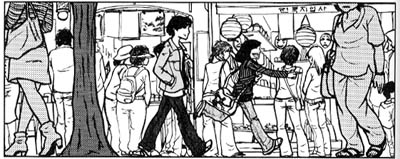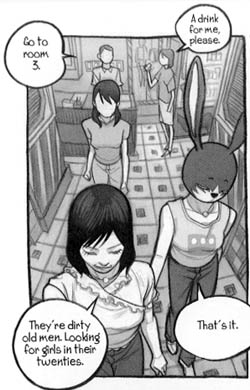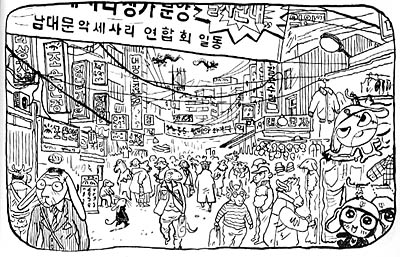 By Guillaume Bouzard, Byun Ki-Hyun, Catel, Chaemin, Choi Kyu-Sok, Igort, Lee Doo-Ho, Lee Hee-Jae, Park Heung-Yong, Mathieu Sapin, Hervé Tanquerelle, and Vanyda
By Guillaume Bouzard, Byun Ki-Hyun, Catel, Chaemin, Choi Kyu-Sok, Igort, Lee Doo-Ho, Lee Hee-Jae, Park Heung-Yong, Mathieu Sapin, Hervé Tanquerelle, and Vanyda
224 pages, black and white
Published by Fanfare/Ponent Mon
Last year, I got a chance to read Japan as Viewed by 17 Creators and ended up finding it what I was hoping for—my own journey from one end of Japan to the other, told through a group of talented French and Japanese comic creators. This year, a companion volume, Korea as Viewed by 12 Creators, was released and I was hoping for much of the same. What I found, though, was a rather different book and not at all what I was expecting this time around.
I think part of the initial shock I had with Korea as Viewed by 12 Creators was that I’d already read Japan. With the earlier book, each story was set in a very specific part of Japan, the book slowly shifting across the island nation’s geography as every creator tried to bring their area to life. Korea as Viewed by 12 Creators is much more generic in its approach to South Korea; there’s a certain sameness to a lot of the stories in terms of setting, while I was expecting to learn more about parts of South Korea that were not Seoul. So while I’m not saying that Korea as Viewed by 12 Creators is a bad book, I do think that people who have already read Japan as Viewed by 17 Creators need to adjust their expectations.
 With that out of the way, there are some real gems in Korea as Viewed by 12 Creators that made the entire book worth reading. Vanyda’s "Oh Pilsung Korea!" is the story that made Seoul come to life the most through me, told through the eyes of a pair of French-Korean siblings who want to see the country their father left. The story is as much about them as Korea itself, but their struggle to fully comprehend Seoul and figure out their own personal connection to the city is fascinating. Vanyda’s art is great too, bringing not only the people but the streets, the parks, the bars, and the subway trains all to life in a detail-heavy style that is still easy to follow. Fanfare/Ponent Mon has also published The Building Opposite by Vanyda, and after reading "Oh Pilsung Korea!" I know that I’ll need to buy this other book from her, and soon.
With that out of the way, there are some real gems in Korea as Viewed by 12 Creators that made the entire book worth reading. Vanyda’s "Oh Pilsung Korea!" is the story that made Seoul come to life the most through me, told through the eyes of a pair of French-Korean siblings who want to see the country their father left. The story is as much about them as Korea itself, but their struggle to fully comprehend Seoul and figure out their own personal connection to the city is fascinating. Vanyda’s art is great too, bringing not only the people but the streets, the parks, the bars, and the subway trains all to life in a detail-heavy style that is still easy to follow. Fanfare/Ponent Mon has also published The Building Opposite by Vanyda, and after reading "Oh Pilsung Korea!" I know that I’ll need to buy this other book from her, and soon.
 Also of particular note is Byun Ki-Hyun’s "The Rabbit," which tackles the traditional view of a woman’s place in society, as a young woman finds a female (humanoid) rabbit having moved in with her. At first it looks like Byun is playing it for humor, joking about the pellets left all over the floor, but once you get past the conceit of the human/rabbit hybrid as the other character, it’s a serious and rather sad story. Several of the stories (Vanyda’s in particular) mention South Korea having changed rapidly in recent years, after the 1988 Summer Olympics were held in Seoul. "The Rabbit" without stating that issue is clearly bringing that problem up to life, with many people’s traditional opinions having not caught up with the influx of technology and globalization that had swept through Seoul. It’s a striking story, and drawn with such a soft, sleek style that it’s hard to not think about it after you’re done. Between "Oh Pilsung Korea!" and "The Rabbit," Korea as Viewed by 12 Creators has already justified its existence with those two stories.
Also of particular note is Byun Ki-Hyun’s "The Rabbit," which tackles the traditional view of a woman’s place in society, as a young woman finds a female (humanoid) rabbit having moved in with her. At first it looks like Byun is playing it for humor, joking about the pellets left all over the floor, but once you get past the conceit of the human/rabbit hybrid as the other character, it’s a serious and rather sad story. Several of the stories (Vanyda’s in particular) mention South Korea having changed rapidly in recent years, after the 1988 Summer Olympics were held in Seoul. "The Rabbit" without stating that issue is clearly bringing that problem up to life, with many people’s traditional opinions having not caught up with the influx of technology and globalization that had swept through Seoul. It’s a striking story, and drawn with such a soft, sleek style that it’s hard to not think about it after you’re done. Between "Oh Pilsung Korea!" and "The Rabbit," Korea as Viewed by 12 Creators has already justified its existence with those two stories.
Several other stories stand out above the rest. Choi Kyu-Sok’s "The Fake Dove" shifts its attention to the streets of Seoul where the tourists don’t go, showing gangs and the homeless while being drawn in a style that is soft and gorgeous in its detail. It’s an unusual opening story for the book, but the more I read the more I realized how different it was from what was to follow. Mathieu Sapin’s "Beondegi" is a humorous, cartoonish story in both script and art that doesn’t really so much bring South Korea or Seoul to life as it almost mocks the idea of a travelogue, told at a fast pace and whipping from one location to the next. It’s so deliberately breaking the mold for what you’d expect that I found myself respecting Sapin’s choices to tell the anti-travel-story here.  Somewhere in-between the two is Hervé Tanquerelle’s "A Rat in the Country of ‘Yong’" which uses animals to tell its story, complete with rats flying in on dragons instead of planes, pigeons serving as taxis, and cats reading a copy of the Lupine Times. It’s a different way to try and translate the experience of visiting South Korea, with fanciful journeys into the past and monsters lurking in the hotel pool. At the same time, though, I found myself respecting Tanquerelle for making such a different take on the country work, and in a way that still ultimately "felt" like South Korea.
Somewhere in-between the two is Hervé Tanquerelle’s "A Rat in the Country of ‘Yong’" which uses animals to tell its story, complete with rats flying in on dragons instead of planes, pigeons serving as taxis, and cats reading a copy of the Lupine Times. It’s a different way to try and translate the experience of visiting South Korea, with fanciful journeys into the past and monsters lurking in the hotel pool. At the same time, though, I found myself respecting Tanquerelle for making such a different take on the country work, and in a way that still ultimately "felt" like South Korea.
In the end, only three of the stories didn’t work for me, although two were not for the reason I was expecting. Catel’s "Dul Lucie" might have been more enjoyable had I read some of Catel’s Lucie graphic novels that she’s famous for in France, but here having Catel shift back and forth between herself and her Lucie-alter-ego as she visits Seoul never quite clicked. Every time we started to get an interesting glimpse into the country itself, the Lucie character would show up again and the mood was lost; had it solely been about Catel’s visit I think I’d have liked it much more. With both Chaemin’s "The Rain That Goes Away Comes Back" and Guillaume Bouzard’s "Operation Captain Zidane," I enjoyed the stories, but couldn’t help but feeling like they didn’t belong in Korea as Viewed by 12 Creators. Neither seemed to benefit in any way by being set in South Korea. Chaemin’s story of relationships and a hospital could just as easily be set anywhere in the world, and while it was drawn beautifully (and I’d definitely like to see more of Chaemin’s comics) it felt out of place. Bouzard’s story at least tied into the World Cup, which featured heavily in several of the stories. When the French artists visited Seoul, the 2006 World Cup was happening in Germany, and just four years earlier it was held partially in South Korea, so the fever over the game was still high. But still, once again, Bouzard’s story had nothing to do with Seoul other than it was mentioned as the location; it could have just as easily been set in Germany, for example, and not have come across any differently. It’s a shame these two stories are the final two in Korea as Viewed by 12 Creators because it ends on a bad note.
Even with a few misfires, though, I did ultimately enjoy Korea as Viewed by 12 Creators. It wasn’t what I was expecting, and I wish I had a greater feel for the country in general, especially locations outside of Seoul. The rare times the book journeyed outside the city, it was in stories that ultimately felt all too short. Still, as Korea as Viewed by 12 Creators is probably the closest I’ll ever get to South Korea on my own, and it was an interesting glimpse into a distant country. If Fanfare/Ponent Mon ever produces a third …as Viewed by Creators book, though, I hope it goes back more to the model of Japan. Korea was good, but my expectations were perhaps set too high by the earlier volume.
Purchase Links: Amazon.com | Powell’s Books
